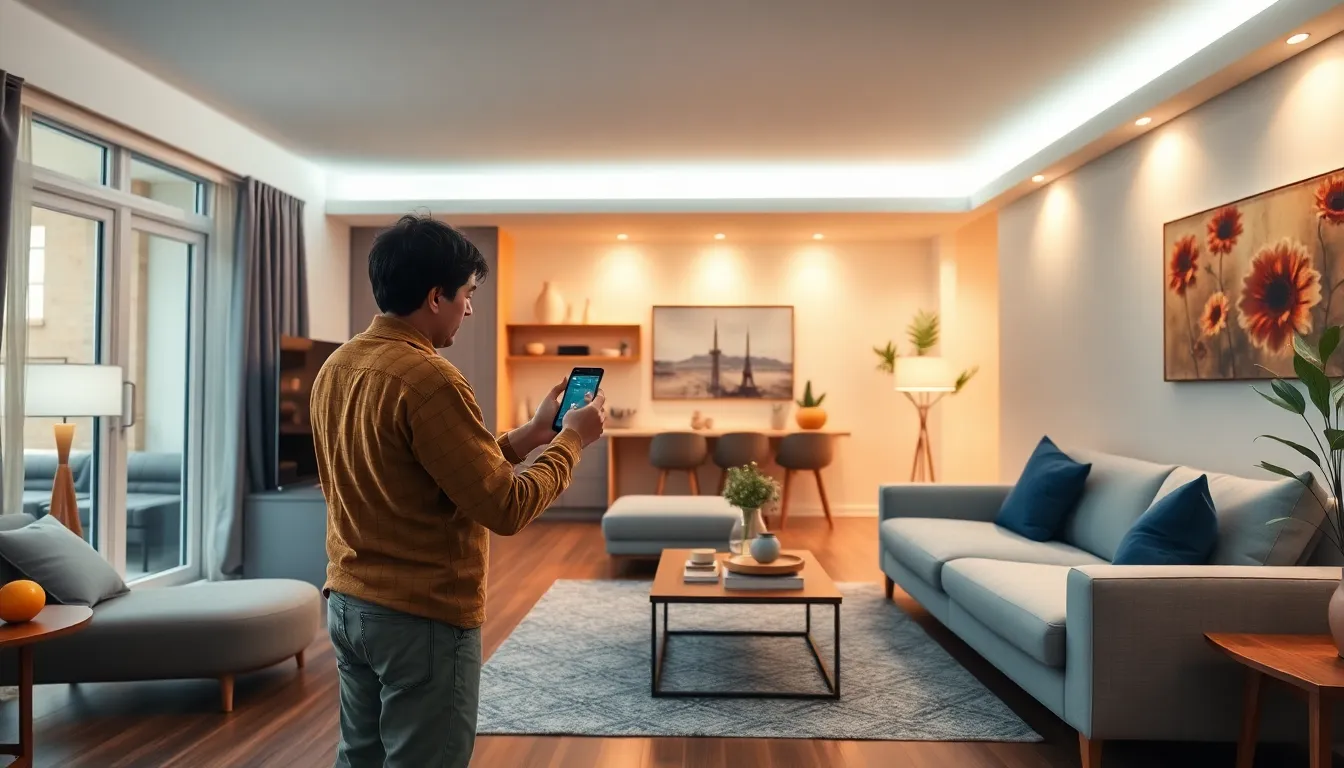Imagine walking into a room and having the lights greet you like an old friend. Smart lighting solutions make this possible, transforming mundane spaces into personalized havens. With a flick of a finger or a simple voice command, anyone can set the mood for a cozy night in or a lively gathering.
These innovative systems not only add convenience but also save energy and enhance security. Who knew that controlling your lights could be as easy as telling your house to “turn down the lights, I’m trying to binge-watch”? The future of lighting is here, and it’s brighter than ever. Whether you’re a tech guru or just looking to impress your guests, smart lighting is the upgrade your home didn’t know it needed.
Table of Contents
ToggleOverview of Smart Lighting Solutions
Smart lighting solutions offer advanced technology that transforms how individuals interact with their environment. Enhancements occur through smart bulbs, LED fixtures, and control systems that connect to home networks. These systems increase convenience by enabling users to adjust lighting via smartphones, voice commands, or automated schedules.
Energy efficiency remains a significant advantage of smart lighting. Many products utilize energy-saving LED technology, which uses up to 75% less energy than traditional incandescent bulbs. This reduction in energy consumption leads to lower utility bills and a smaller environmental footprint.
Security features enhance the appeal of smart lighting systems. Users can program lights to simulate occupancy, deterring potential intruders when they are away. Furthermore, motion sensors activate lights when movement is detected, increasing safety both indoors and outdoors.
Customization stands out as another benefit. Many systems allow users to choose from a wide range of colors, brightness levels, and schedules to create desired atmospheres for various occasions. Examples include setting soft white tones for relaxing evenings or bright colors for entertaining guests.
Compatibility with other smart home devices improves functionality. Integration with smart speakers and home assistants creates seamless control, making it easy for users to manage lighting alongside thermostats and security systems. This interconnectedness enhances overall home automation.
Smart lighting solutions elevate home experiences by providing energy savings, security measures, customization options, and seamless integration with other technologies. These features make them an excellent investment for modern living.
Benefits of Smart Lighting

Smart lighting solutions offer numerous advantages for modern homes and lifestyles. They enhance energy efficiency, convenience, and security while allowing personalization.
Energy Efficiency
LED technology drives the energy efficiency of smart lighting solutions. Many products reduce energy consumption by up to 75% compared to traditional bulbs. These significant reductions lead to lower utility bills and decreased environmental impact. Smart lighting systems often include features like timers and sensors that further optimize energy use. Users can set schedules, ensuring lights operate only when necessary. This intelligent usage not only saves money but also contributes to sustainable living practices.
Enhanced Convenience
Convenience plays a crucial role in the popularity of smart lighting solutions. Users can control lights through smartphones, voice commands, and automated schedules. Instant adjustments accommodate various moods and occasions seamlessly. Scheduling settings allow lights to turn on or off automatically, making homecoming effortless. Compatibility with other smart home devices enhances this convenience, enabling integrated control over multiple systems. Elevated convenience simplifies daily routines, offering an intelligent lighting experience that adapts to individual needs.
Types of Smart Lighting Solutions
Smart lighting solutions come in various forms, providing enhanced convenience and customization for users. Three popular types include smart bulbs, smart light switches, and smart LED strips.
Smart Bulbs
Smart bulbs offer versatile lighting options and convenient control features. Users can adjust brightness and color through smartphones or voice commands. Many smart bulbs are energy-efficient, reducing energy consumption by up to 75% compared to traditional incandescent bulbs. Compatibility with popular smart home systems makes these bulbs easy to integrate and manage. These lighting solutions often feature scheduling capabilities, enabling lights to turn on and off at specific times. Some models even come with advanced features, like syncing to music for dynamic lighting effects.
Smart Light Switches
Smart light switches provide an effective way to control multiple lights within a room. Users install them in place of standard light switches, allowing for remote operation through smartphones or voice assistants. Customization options enable users to create lighting scenes suitable for different activities, such as reading or entertaining. Many smart switches incorporate energy monitoring, allowing users to track usage patterns. Furthermore, they enhance home security by enabling scheduled lighting, simulating occupancy when residents are away. With straightforward installation processes, anyone can upgrade to smart light switches without professional help.
Smart LED Strips
Smart LED strips offer dynamic lighting possibilities for various applications. These strips can be installed along walls, under cabinets, or in outdoor spaces to create ambient lighting. Users can choose from a wide array of colors and effects, making it easy to set the mood for any occasion. Control options include mobile apps and voice commands for seamless operation. Smart LED strips often feature music synchronization, allowing lights to pulse and change with the rhythm. Their flexibility in design accommodates diverse styles, perfectly complementing modern home decor.
Popular Smart Lighting Technologies
Smart bulbs stand out as one of the most favored options in smart lighting technologies. They provide users with versatile lighting options and energy efficiency through LED technology. Users adjust brightness and color easily using smartphones or voice commands.
Smart light switches serve another essential role. These devices allow control of multiple lights simultaneously, while also enabling customization for different activities. By replacing traditional switches, they enhance overall functionality in homes.
Smart LED strips add dynamic lighting possibilities to any space. Users can select from a vast array of colors and effects, allowing for creative personalization. These strips work well in both ambient and task lighting scenarios.
Smart lighting hubs consolidate control over various lighting systems. They connect multiple devices into a single interface, streamlining user experience. With centralized control, managing lights becomes efficient and seamless.
Motion sensors enrich security features within smart lighting. These devices activate lights upon detecting movement, ensuring safety when entering a premises. Additionally, programming lights to simulate occupancy further deters potential intruders.
Automated schedules offer significant convenience. Users can set specific times for lights to turn on or off, aligning with daily routines. This feature enhances energy savings by ensuring lights operate only when necessary.
Voice-activated assistants revolutionize smart lighting management. Integrating these with smart lighting systems allows for hands-free control. Users can issue commands easily, creating an effortless interaction with their home environment.
Overall, popular smart lighting technologies cater to various needs, enhancing convenience, efficiency, and security. Both tech enthusiasts and those new to smart home systems find these options appealing. Each type of solution plays a vital role in transforming ordinary spaces into personalized, intelligent environments.
Installation and Setup
Installing smart lighting solutions involves several straightforward steps. Begin by selecting the appropriate smart bulbs, light switches, or LED strips based on specific needs. Assess compatibility with existing fixtures and home networks to ensure a seamless integration.
Next, prepare the installation area. Turn off the power to the electrical circuit before replacing standard bulbs with smart options. For light switches, remove the old switch, connecting wires to the new smart switch according to manufacturer’s instructions.
After installation, power on the lights and follow the app’s setup process. Download the respective mobile app that controls the smart lighting system, and create an account if needed. Connect the lights to the home Wi-Fi network, ensuring a stable connection for proper functionality.
Users should configure settings within the app. Set schedules for automatic on and off times, adjust brightness levels, and choose colors if applicable. Voiced commands through smart assistants can also enhance convenience, allowing for quick adjustments without manual input.
Testing the installed system provides assurance of correct functionality. Check each light for responsiveness to both app commands and voice controls. If issues arise, consult troubleshooting guides provided by the manufacturer.
Each smart lighting solution is unique, so understanding the specific instructions for the chosen products is essential for a successful setup. Embracing these technologies simplifies daily routines and enhances user experience, bringing personalized lighting to any environment.
Smart lighting solutions are revolutionizing the way people experience their living spaces. By offering control at their fingertips and enhancing energy efficiency, these systems create a more personalized environment. The added security features and customization options make them an attractive choice for any homeowner.
As technology continues to evolve, smart lighting will only become more integrated into daily life. Its ability to adapt to individual preferences and routines ensures that it remains a valuable investment. Embracing these innovations not only elevates home aesthetics but also contributes to a more sustainable lifestyle. The future of lighting is bright with smart solutions leading the way.



